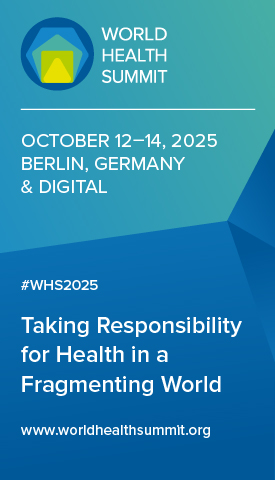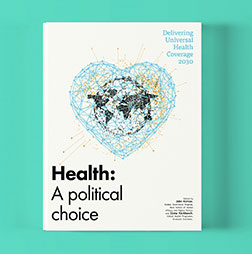From crisis to cohesion: A new mandate for health and multilateralism
The Covid-19 pandemic brought health systems to a standstill. Its aftershocks still reverberate around the world. Routine immunisation, non-communicable disease screening and per capita health spending remain below pre-pandemic levels. In 2024 alone, the world experienced 17 significant disease outbreaks including H5N1, Marburg virus and hMPV. New biological threats and the resurgence of communicable diseases expose persistent gaps in global pandemic preparedness.
Climate change, a defining issue of our times, is a threat multiplier for health systems. It rapidly accelerates disease transmission, increases disaster risks, intensifies nutritional challenges and displaces populations in low-resource settings. Over the next 25 years, climate change could cause over 15 million excess deaths in low- and middle-income countries. Economic losses due to climatic risks associated with health could exceed $20.8 trillion in LMICs.
Deepening political polarisation weakens the global cooperation essential for scientific progress and amplifies conflict. The number of geopolitical disturbances is at an all-time high, displacing over 122 million people and eroding access to essential health services. In 2023, false health claims amassed over 4 billion views across digital platforms, compromising vaccine uptake and fuelling health-related conspiracy theories. Exponential technological advances in artificial intelligence outpace public health governance systems, creating new ethical and equity dilemmas.
Health is no longer a downstream consideration; it is the front line of our security.
Asia and the Pacific health at a crossroads
The Asia Pacific region faces a convergence of structural vulnerabilities that threaten its health gains, adding pressure on its economic growth and developmental future.
The most disaster-prone region in the world, Asia and the Pacific accounted for over 40% of global climate-related disasters over the past two decades. In 2022, the region experienced over 140 disasters that affected more than 64 million people and resulted in approximately $57 billion in economic damage. With rising sea levels in the Pacific, heatwaves in South Asia and typhoons in Southeast Asia, climate shocks drive unprecedented internal displacement, food insecurity and disease burdens.
The triple burden of disease – the unfinished agenda of maternal and child health, the rising silent pandemic of non-communicable diseases and the re-emergence of communicable diseases – combined with the persistent challenge of malnutrition, unmet needs in early childhood development, growing concerns about mental well-being and threats of other emerging diseases, as well as the rising toll from trauma, injury and ageing populations, has placed countries across Asia and the Pacific under immense strain. Health systems face acute infrastructure gaps, critical workforce shortages and persistent inequities in service delivery, making it increasingly difficult to address the complex and evolving health needs of their people. Post-pandemic fiscal tightening has constrained health budgets, with debt-to-gross domestic product ratios exceeding 80% in parts of the region.
Rapid urbanisation further complicates these challenges. The lack of essential social determinants such as clean water and air, sanitation, and nutrition substantially increases the risk of infectious and non-communicable diseases. Health remains inadequately integrated into broader national development agendas – disconnected from economic, infrastructure and climate strategies. Fragmented governance and underfunded local systems further hinder integrated service delivery and community health resilience.
Steadfast political action and diversified financing streams are needed to safeguard Asia and the Pacific from emerging and systemic health shocks. To fulfil its potential, the region must show urgency and deploy a whole-of-systems approach for health sector transformation.
Doing more with less
The region’s premier development and international financial institutions are leveraging their capital outlay, political convening strength and knowledge leadership to place health at the centre of Asia and the Pacific’s future agenda. There is an urgent need to navigate the fractured landscape by anchoring health as a driver of long-term security, economic growth and resilience.
For decades, health has remained disconnected from broader development agendas. International financial institutions must leverage their political convening and technical expertise to forge bridges of regional cooperation. Mainstreaming health with a whole-of-systems approach is essential to proactively shaping resilient, integrated and future-ready systems. It is important for IFIs to build long-term strategies and operational plans that embed health within broader economic, infrastructure and climate strategies. Aligning national cross-sectoral programming and global platforms such as the G20, United Nations climate conferences and the World Health Summit can elevate the health agenda in the region’s future pathway. The Multi-Bank Working Group on Health and Climate, led by the World Bank and co-led by the Asian Development Bank, is an excellent example of collaboration to align strategies, pool expertise and mobilise financing at scale. Beyond financing, it symbolises a shift toward collective stewardship of global public goods. It demonstrates that IFIs can transcend institutional silos to tackle cross-border challenges where no single institution can succeed alone.
In parallel, those institutions need to unlock innovative financial pathways to amplify health investments. They need to deploy blended finance initiatives, public-private partnerships and outcome-based financing tools to mobilise private capital for health. Recently, IFIs have committed billions in health-related financing across the Asia and Pacific region. This has included landmark support for vaccine access facilities, delivery of hundreds of millions of Covid-19 vaccines and mobilisation of large-scale response packages combining grants, loans and technical assistance. However, their mandate needs to broaden beyond investing in universal health coverage to mobilise capital for emerging areas including the climate-health nexus, mental health, nutrition, rapid urbanisation, demographic shifts, digitalisation and NCDs. IFIs’ ability to use their balance sheets for de-risking, technical assistance and policy-and-results-based disbursements can attract new actors and accelerate reform. This can create a virtuous cycle of facilitating investments that create regional cooperation for sustainable and scalable impact.
The G20 Pandemic Fund is a beacon of catalytic multilateralism funding in a fragmented world. Launched in 2022 with over $2 billion pooled from governments, philanthropies and multilateral development banks, it strengthens pandemic preparedness in LMICs. Every dollar awarded from the Pandemic Fund has generated an estimated $7 in additional financing. The fund demonstrates that countries can still unite on shared threats, offering hope and a template for collective action on global challenges.
In a region facing compounding shocks, IFIs need to transform their approach by developing integrated models of finance, policy and advocacy. Doing more with less is not just about efficiency. It is about redefining health as the essential lifeline in a fractured world.












